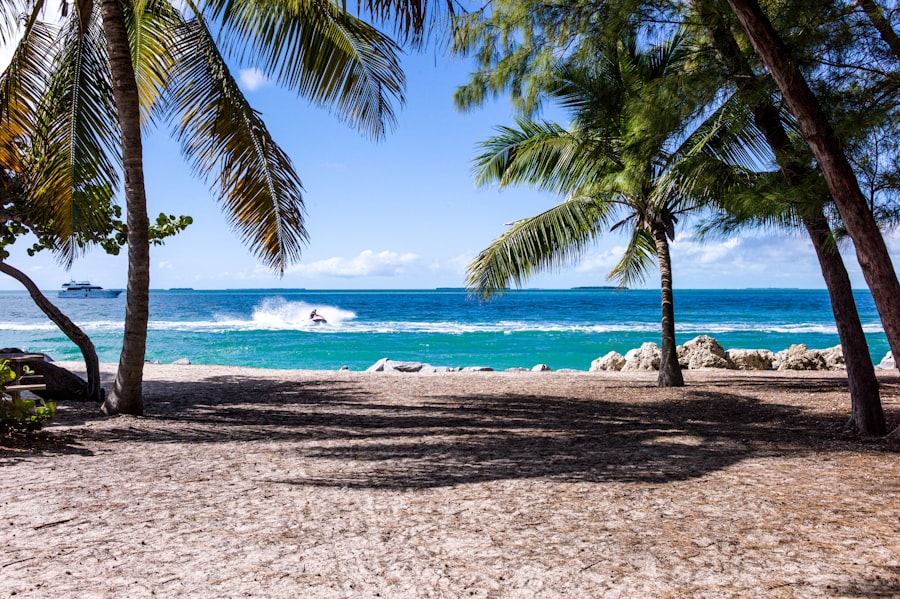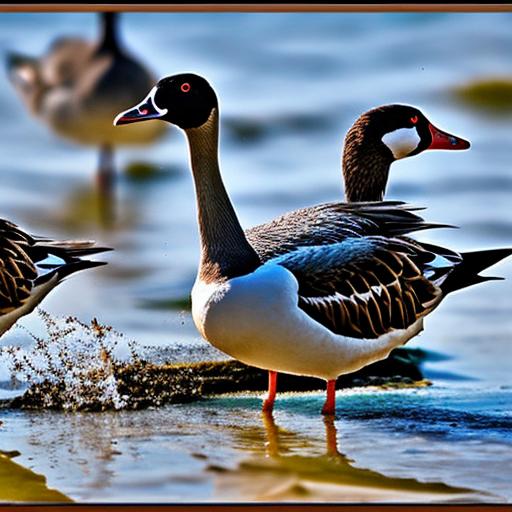Beaches are a popular destination for people seeking relaxation and enjoyment. However, in recent years, many beaches have been facing a growing problem – geese. These birds have become a nuisance, causing damage to the environment and creating unsanitary conditions. It is important to address this issue in order to preserve the beauty and cleanliness of our beaches.
The presence of geese on beaches can lead to a number of problems. Firstly, their droppings can be unsightly and unhygienic. Geese produce a large amount of waste, which can accumulate on the sand and in the water, making it unpleasant for beachgoers. Additionally, their droppings contain high levels of bacteria, which can pose a health risk to humans and other animals.
Furthermore, geese can cause damage to the natural habitat of beaches. They feed on grasses and other vegetation, which can lead to erosion and destruction of dunes and other fragile ecosystems. This can have long-term negative effects on the biodiversity and overall health of the beach environment.
Key Takeaways
- Geese can be a problem on beaches due to their droppings and aggressive behavior.
- Understanding geese behavior and habits can help in developing effective deterrent strategies.
- Natural deterrents like planting tall grass and using decoys can be effective in keeping geese away.
- Artificial deterrents like noise makers and lasers can also be used to scare geese off beaches.
- Physical barriers like fences and netting can be installed to prevent geese from accessing beaches.
Understanding Geese Behavior and Habits
To effectively address the geese problem on beaches, it is important to understand their behavior and habits. Geese are attracted to beaches for several reasons. Firstly, beaches often provide an abundant food source for them. They feed on grasses and other vegetation found near the shoreline. Additionally, beaches provide open spaces with clear sightlines, allowing them to easily spot potential predators.
Geese are also attracted to beaches because they offer a safe haven for nesting and raising their young. The wide open spaces and lack of natural predators make beaches an ideal location for geese to build their nests and rear their offspring.
The impact of geese on beaches is significant. Their feeding habits can lead to the destruction of vegetation, which in turn can cause erosion and loss of habitat for other species. Their droppings not only create unsightly and unhygienic conditions, but also contribute to the pollution of water bodies, posing a threat to marine life.
Natural Deterrents for Geese on the Beach
One approach to managing geese on beaches is through the use of natural deterrents. These are methods that make the beach environment less attractive to geese, encouraging them to seek alternative locations.
One example of a natural deterrent is the use of tall grasses and shrubs. By planting these types of vegetation along the shoreline, it creates a barrier that makes it more difficult for geese to access the beach. Additionally, these plants provide an alternative food source for geese, reducing their reliance on the grasses and vegetation found on the beach.
Another natural deterrent is the use of predator decoys. Placing decoys such as plastic owls or coyotes near the shoreline can create the illusion of a potential threat to geese, causing them to avoid the area. It is important to regularly move these decoys to prevent geese from becoming accustomed to their presence.
To use natural deterrents effectively, it is important to understand the behavior and habits of geese. For example, geese are attracted to open spaces with clear sightlines, so planting tall grasses and shrubs strategically can create barriers that discourage their presence. Additionally, regularly moving predator decoys can help maintain their effectiveness.
Artificial Deterrents for Geese on the Beach
In addition to natural deterrents, there are also artificial deterrents that can be used to manage geese on beaches. These are man-made devices or structures that are designed to discourage geese from congregating on the beach.
One example of an artificial deterrent is a sonic device that emits loud noises or distress calls. These sounds can startle geese and make them feel unsafe, causing them to leave the area. It is important to use these devices sparingly and strategically, as geese can become accustomed to the noise over time.
Another artificial deterrent is the use of visual deterrents, such as reflective tape or balloons. These objects create a visual disturbance that can deter geese from landing or staying on the beach. It is important to regularly move and change the location of these visual deterrents to prevent geese from becoming accustomed to their presence.
To use artificial deterrents effectively, it is important to consider the specific needs and behaviors of geese. For example, sonic devices should be used sparingly to prevent geese from becoming habituated to the noise. Additionally, regularly moving and changing the location of visual deterrents can help maintain their effectiveness.
Creating Physical Barriers to Keep Geese Away
Another approach to managing geese on beaches is through the use of physical barriers. These are structures or devices that physically prevent geese from accessing the beach.
One type of physical barrier is a fence or netting. These can be installed along the shoreline to create a physical barrier that prevents geese from entering the beach area. It is important to ensure that the fence or netting is tall enough and securely installed to prevent geese from flying over or crawling under it.
Another type of physical barrier is a floating barrier. These are devices that are placed in the water near the shoreline to create a barrier that prevents geese from swimming onto the beach. Floating barriers can be made from materials such as ropes or buoys, and should be regularly maintained to ensure their effectiveness.
To install physical barriers effectively, it is important to consider the specific needs and behaviors of geese. For example, fences or netting should be tall enough and securely installed to prevent geese from accessing the beach. Additionally, floating barriers should be regularly maintained to prevent them from becoming damaged or ineffective.
Educating the Public on Geese Behavior and the Importance of Keeping Them Away from Beaches

In order to effectively address the geese problem on beaches, it is important to educate the public on geese behavior and the importance of keeping them away from beaches. Public education plays a crucial role in raising awareness and encouraging responsible behavior.
One way to educate the public is through signage and informational materials. By placing signs and distributing brochures or pamphlets at beach entrances and other high-traffic areas, beachgoers can be informed about the impact of geese on beaches and the importance of keeping them away. These materials should provide information on how to identify geese, their behavior, and the potential risks associated with their presence.
Another way to educate the public is through community outreach programs and events. By partnering with local organizations or authorities, educational workshops or presentations can be organized to inform the public about geese behavior and the importance of responsible beach use. These events can also provide an opportunity for beachgoers to ask questions and seek further information.
To educate the public effectively, it is important to use clear and concise messaging that is easily understood by a wide range of audiences. Additionally, providing visual aids such as photographs or videos can help reinforce the information being presented. It is also important to regularly update educational materials and programs to ensure that they remain relevant and engaging.
The Role of Dogs in Keeping Geese off Beaches
Dogs can play a valuable role in controlling geese on beaches. Their presence can deter geese from landing or staying on the beach, as they are natural predators to these birds.
One way dogs can help control geese is through their natural instinct to chase and bark at them. By allowing dogs on beaches or using trained dogs specifically for this purpose, geese can be discouraged from landing or staying in the area. It is important to note that not all dogs are suitable for this task, as some breeds may have a higher prey drive or be more aggressive towards geese.
To use dogs effectively, it is important to ensure that they are properly trained and under control at all times. Dogs should be trained to respond to commands and should not be allowed to harm or harass geese. Additionally, it is important to consider the safety and comfort of both the dogs and beachgoers, and to follow any local regulations or restrictions regarding dogs on beaches.
Environmental Considerations for Geese Control on Beaches
When implementing strategies to control geese on beaches, it is important to consider the potential impact on the environment. It is crucial to find a balance between managing the geese problem and preserving the natural habitat of beaches.
One way to minimize the impact on the environment is through the use of environmentally friendly deterrents. For example, using natural deterrents such as tall grasses and shrubs or predator decoys does not introduce any harmful chemicals or substances into the environment. Similarly, physical barriers such as fences or netting can be made from sustainable materials that do not harm the environment.
Another consideration is the timing of geese control measures. It is important to implement these strategies during non-breeding seasons or when geese are less likely to be nesting or raising their young. This helps minimize disruption to their natural life cycle and reduces the risk of harm to geese or their offspring.
To minimize the impact on the environment, it is important to regularly monitor and assess the effectiveness of geese control measures. If a particular strategy is found to be ineffective or causing unintended harm, it should be adjusted or discontinued. Additionally, it is important to involve environmental experts or organizations in the planning and implementation of geese control measures to ensure that they are environmentally responsible.
Collaborating with Local Authorities and Organizations to Manage Geese on Beaches
Managing geese on beaches requires collaboration between local authorities, organizations, and the public. By working together, a more comprehensive and effective approach can be developed and implemented.
Local authorities play a crucial role in managing geese on beaches. They have the authority to enforce regulations and restrictions, and can provide resources and support for geese control measures. It is important to engage with local authorities early in the planning process to ensure that any proposed strategies align with existing regulations and policies.
Organizations such as environmental groups or bird conservation societies can also provide valuable expertise and resources. They can help assess the impact of geese on beaches and provide guidance on the most effective and environmentally responsible strategies for managing them. Additionally, these organizations can help raise awareness and educate the public about geese behavior and the importance of keeping them away from beaches.
To collaborate effectively, it is important to establish clear lines of communication and coordination between all stakeholders. Regular meetings or consultations should be held to discuss progress, share information, and address any concerns or challenges that may arise. It is also important to regularly evaluate the effectiveness of collaborative efforts and make adjustments as needed.
Strategies for Long-Term Geese Control on Beaches
In conclusion, addressing the geese problem on beaches requires a multi-faceted approach that combines natural deterrents, artificial deterrents, physical barriers, public education, the use of dogs, consideration of environmental impacts, and collaboration with local authorities and organizations.
By understanding geese behavior and habits, we can implement strategies that make beaches less attractive to them. Natural deterrents such as tall grasses and shrubs or predator decoys can discourage geese from landing or staying on the beach. Artificial deterrents such as sonic devices or visual disturbances can also be effective in deterring geese.
Physical barriers such as fences or netting can physically prevent geese from accessing the beach. Dogs can play a valuable role in controlling geese through their natural instinct to chase and bark at them. It is important to use dogs responsibly and ensure their training and control.
Public education is crucial in raising awareness and encouraging responsible behavior. By educating the public about geese behavior and the importance of keeping them away from beaches, we can foster a sense of responsibility and cooperation.
Consideration of environmental impacts is essential in implementing geese control measures. By using environmentally friendly deterrents and timing control measures appropriately, we can minimize harm to the environment and preserve the natural habitat of beaches.
Collaboration with local authorities and organizations is key in developing and implementing effective geese control strategies. By working together, we can leverage resources, expertise, and authority to address the geese problem on beaches more comprehensively.
In conclusion, it is important to take action to address the geese problem on beaches. By implementing these strategies for long-term geese control, we can preserve the beauty and cleanliness of our beaches for future generations to enjoy.
If you’re looking for effective ways to keep geese off the beach, you might also be interested in learning about turning a shed into a chicken coop. This article from Poultry Wizard provides valuable insights on how to repurpose a shed into a functional and secure space for your chickens. By implementing the right design and features, such as proper ventilation, nesting boxes, and predator-proofing measures, you can create a safe haven for your feathered friends. Check out the article here to discover more about this innovative approach to poultry housing.
FAQs
What are the common problems caused by geese on the beach?
Geese can cause a number of problems on the beach, including leaving behind droppings that can be unsightly and unsanitary, damaging vegetation, and potentially attacking beachgoers.
What are some methods for keeping geese off the beach?
There are several methods for keeping geese off the beach, including using decoys, installing fencing or netting, using noise deterrents, and using trained dogs to scare off the geese.
What is the most effective way to keep geese off the beach?
The most effective way to keep geese off the beach will depend on the specific situation and location. However, a combination of methods, such as using decoys and noise deterrents, may be the most effective approach.
Are there any humane methods for keeping geese off the beach?
Yes, there are humane methods for keeping geese off the beach, such as using trained dogs to scare off the geese or using noise deterrents that do not harm the birds.
What should I do if I encounter aggressive geese on the beach?
If you encounter aggressive geese on the beach, it is important to stay calm and avoid approaching them. Slowly back away and give the geese plenty of space. If the geese continue to be aggressive, it may be necessary to contact local authorities for assistance.
Meet Walter, the feathered-friend fanatic of Florida! Nestled in the sunshine state, Walter struts through life with his feathered companions, clucking his way to happiness. With a coop that’s fancier than a five-star hotel, he’s the Don Juan of the chicken world. When he’s not teaching his hens to do the cha-cha, you’ll find him in a heated debate with his prized rooster, Sir Clucks-a-Lot. Walter’s poultry passion is no yolk; he’s the sunny-side-up guy you never knew you needed in your flock of friends!







